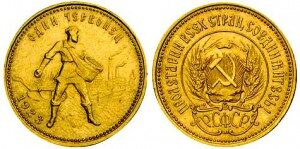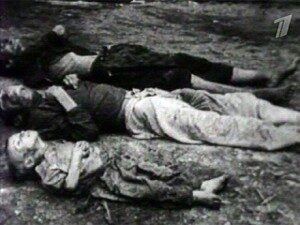Paradoxically the famine mostly affected fertile areas in the North Caucasus, the Volga basin, the South Urals, Western Siberia, Ukraine, Belorussia and Kazakhstan. During the last decade several Western historians were recruited to elaborate on the theory that the famine tragedy was a deliberate act of genocide against Ukrainians carried out by Stalin's government. Let's consider the historical facts and try to get closer to the truth regarding the issue of the sources and circumstances of that horrible famine in the USSR.
First of all we have to recall something about the Gold, which surprisingly not always is a mean of payment...
In early 1920s the recently proclaimed Soviet Union was anxious about restoration of its industry totally destroyed after WWI and Civil War in Russia (1918-1921). The Soviets desperately needed modern machinery and industrial equipment. How could they pay it? Soviet government was able to offer to the international market three items: grain, minerals and gold.
On Genoa Conference in 1922 the new Gold Exchange Standard was introduced. Since the end of 1922 the Soviet Union was issuing the golden chervonets - a new Soviet currency fully covered by the golden reserves and convertible to gold. In 1923 the Soviet chervonets was one of the most stable and secured currencies of the world. It represented a clear and present danger for emerging financial epicentre - the United States of America. The economic and financial weight of the United States boomed astonishingly as the result of global war. That country was one of few beneficiaries of the man-slaughtering house in Europe of 1910s. But an unexpected rival from the Bolshevik stated emerged vigorously...
In 1924 the Soviet chervonets was replaced by a softer rouble without golden equivalent. The menace to the US dollar and British pound was diminished. In return Soviet Union was recognized by the UK, France, Norway, Austria, Greece, Sweden, Denmark, China, Japan, Mexico and other countries. The United States possessed 46% of golden reserves of the capitalist world.
In 1925 the Soviet leadership decided to accelerate industrialization of the country. Quite surprisingly despite enormous economic gains promised by such policies, the Western countries refused to accept gold as payment when trading with Soviet Union! This amazing behaviour is known in history as the "gold blockade". The USSR could pay for machinery and equipment only by oil, timber and grains. (Interestingly, they still accepted pre-revolution Imperial Russian golden coins - the currency of a non-existent state was not dangerous!)
In 1929 the US bankers initiate the Great Depression. The short period of international currency exchange stability was over.
In 1931 Germany and Austria failed to repay the foreign debt and stop exchanging marks into gold, thus abolishing Gold Exchange Standard. By the autumn 1931 the UK suspends the gold exchange as well.
As you see, it would be a logical and natural move to lift the golden blockade of Soviet Union at that time, thus allowing Soviet gold to relieve the suffocating Western economies. But the decision they was taken at that circumstances was shocking in its absurdity. They not only left the gold blockade of the USSR in force, but also imposed a severe trade embargo on the major part of Soviet export! It was done despite acute economic crisis in the West where most producers were interested in any kind of demand, especially paid by gold, timber, oil and other raw material from the Soviet Union. E.g. in 1932 80% of British machinery export was being supplied to the USSR. Nevertheless, on April 17, 1933 the British government introduced embargo: Russian Goods (Import Prohibition) Act 1933! What was the logic? It was a politically motivated decision to pressure the tenacious Soviet government powered by the antagonistic ideology and economic structure.
Comment: History repeating itself, once again economic sanctions may be hurting the West more than Russia. See:
Was the traded between the West and the USSR totally cut down? Absolutely not. Soviet demand for Western technologies and machinery was even higher than ever: the industrialization was full-pelt. But now the West was expecting only one mean of payment: the Soviet grains! (The curiosity of this claim is emphasized by the fact that by that time the currencies of the most agrarian countries were significantly devalued and the demand for grains on world market was cut 50-70%!)
Then Stalin's government was faced with a choice: either to give up restoring industry, so capitulating to the West, or continue industrialising, leading to a dreadful internal crisis. If the Bolsheviks took grain away from the peasants, there was the very great probability of a famine which, in turn, might lead to internal unrest and removal from power. So no matter what Stalin chose, the West would remain victorious. Stalin and his entourage decided to force their way through and stop at nothing.
The government collected grain and sent it to the West, but not to starve part of a country's population to death, but because there was no other way it could pay for the supply of equipment. All of Stalin's hopes were on a new harvest. It turned out to be a small one, however, since the country was struck by a drought. The USSR was unable to buy food in exchange for gold (the gold blockade) or currency (as a result of the embargo there was none). Attempts were urgently made to get supplies of grain from Persia, where they had agreed to accept gold. The authorities did not have time, however, as a catastrophe was already underway.
Between 1932 and 1933, thousands and thousands of people died and it was only after this that the West was once again renewed to accept oil, timber and precious metals from the Soviets.
In October 2008, the European Parliament recognised the Holodomor in the Ukraine as a crime against humanity. The guilty was put on the 'Stalinist USSR'. However, the report by the European Parliament did not provide answers to two questions:
- why did the capitalists behave so "strangely", refusing to accept Stalin's gold?
- why did they only want to receive grain from the USSR as payment?
There is neither truth nor logic in the European Parliament's reports. The truth is that in 1934, grain exports from the USSR completely stopped. By order of the Soviet government...
The famine of 1932-33, which was carefully organized by the West, did not have the desired effect: the Bolsheviks remained in power. They continued industrializing. Economic measures had no effect - Stalin was restoring the country at any price. Only military measures remained. And exactly in 1933 Adolf Hitler, who had openly written about his expansionist aims in the vast Russian plains, came to power in Germany...
ORIENTAL REVIEW has completed exclusive translations of the chapters from Nikolay Starikov's documentary research ""Who Made Hitler Attack Stalin" (St.Petersburg, 2008). Mr. Starikov is Russian historian and civil activist. The original text was adapted and translated by ORIENTAL REVIEW.






Comment: Food as a weapon, sadly no shortage of examples:
Genocide by Other Means [link] The Bengal Famine [link], [link] Irish Potato Famine [link], [link] Gaza agriculture decimated by Israeli offensive [link].